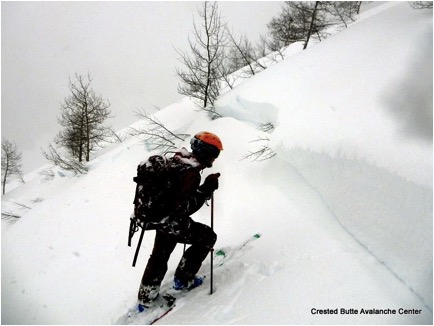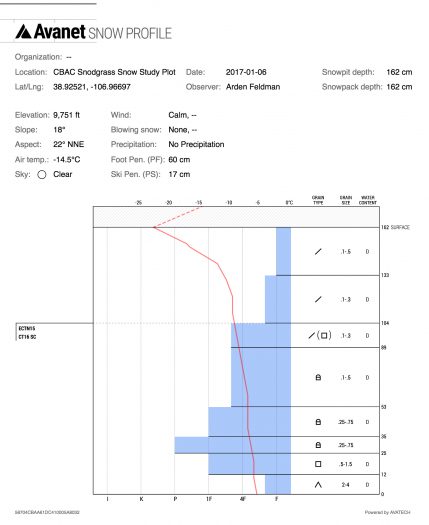January 20th – 27th: Three Storms Bury a Widespread Surface Hoar Layer
By Arden Feldman CBAC Intern
The week consisted of three separate storms that kept clouds and snow in the air for most of the week. The first storm began on the night of the 19th and continued through the afternoon of the 20th. It brought with it low-density snow and very little wind, preserving and burying the surface hoar that had grown and had been observed on all aspects up to at least 12,000 feet in elevation. The western part of the zone received significantly higher snow totals with 24” of new snow reported in the paradise divide zone on the 20th. Schofield received .7” of SWE and Mt. Crested Butte received .4” of SWE.
On the 21st, the second storm came in lighter than forecasted and resulted in mostly light snow showers across the zone. Schofield received .3” of SWE. A small ridge then formed over the western US on the 22nd allowing for a short break in the storm pattern. The third storm combined Pacific moisture and a strong upper level jet to hit our area ferociously on the 23rd. We experienced extreme southwest winds and intense snow transport, even in town. During the day on the 23rd, Scarp Ridge recorded consistent 60 mph winds and a maximum gust of 111 mph. Schofield received 2” of SWE and Mt. Crested Butte received 1” of SWE.
From the 24th through the end of the week on the 26th, the third storm exiting to our east brought a northwest flow over our area causing light snow, generally broken skies, and cold temperatures.
This week’s snow buried a widespread surface hoar layer on all aspects along with a reactive faceted crust on southerly tilts. In the beginning of the week, the slab above it was too soft and thin for failures to propagate, but as the snow accumulated over the week, the slab grew and the surface hoar layer became very reactive. Numerous natural and skier triggered avalanches were observed failing on the surface hoar, even on low angle slopes, in relatively dense aspen groves, and as remote triggers. The avalanche danger was rated at considerable or high every day of the week other than the first day of the storm, Jan 20th. In places, the surface hoar layer was deceptively touchy: we had several field days where it didn’t produce propagating results in ECTs but was easily triggered on steep terrain. The extreme southwest winds with intense snow transport likely created wind slabs in the alpine, but with continued snow transport and limited alpine views, evidence of them was likely quickly covered up. Over the course of the week, 39 natural and 37 human triggered avalanches were observed, and we had limited views of alpine terrain.
1/30/17 Avalanche Rose
This avalanche rose displays avalanche activity that we believe failed on the 1/19 persistent weak layer interface. In most cases, this is on surface hoar, but on some cases on southerly aspects, this was on a crust/facet layer. This is meant to show a general pattern , and there are some strong sampling biases to consider. First, we did not have views of above treeline terrain 7 days while the weak layer was being buried and failing. If there was evidence of natural avalanche activity above treeline on PWL, it was likely brushed over by subsequent snow/winds before we set eyes on it. We also have very few due north and northwest paths near town, and a lot of human traffic is concentrated on NE and E aspects at lower elevations. I think the take-home point here is that the action has been most concentrated near and below treeline, especially and NE/E aspects, but poor structures exist around the compass, and we have significantly less persistent slab data and lower confidence for above treeline slopes. Size is generally larger on leeward aspects and higher elevations. This rose does not include wind slabs that appeared to break in mid-storm layers and will be healing quickly now. -Zach Guy
January 13th – 19th: Cut Off Low and Surface Hoar Formation under Brief High Pressure
By Arden Feldman CBAC Intern
The same cut off low from January 12th continued to impact Colorado until the 16th. It slowly meandered from Baja to the Arizona/Mexico Border and finally on to Texas while spinning multiple ripples of moisture into our area with increasingly less favorable atmospheric flow directions. This kept light snow showers and cloud cover over Crested Butte until the 16th. Schofield received .5” of SWE on the 13th and .4” of SWE on the 14th. CBMR reported 3” of new snow on the morning of the 14th, another 3” on the 15th, and 1” on the 16th.
The weak trough slowly slid its way far enough east to allow for high pressure to build over Colorado on the 16th. The high pressure lasted through the end of the week, allowing for the first major break in storminess in over two weeks. A pleasant reminder that the sun does in fact still exist! Although the sun was out at high elevations, impressive inversions created spectacular valley fog unusual for our area. Clear, calm nights allowed for widespread surface hoar growth. At the end of the week, on the evening of the 19th, snow began to fall again, burying the surface hoar and making it our next problematic persistent weak layer.
Last week’s historic storm left us with dense slabs, generally 3-5 feet thick, plastered across all aspects. These slabs are sitting on persistent weak layers at the storm interface and down near the ground. Clearing skies over the week finally gave views of avalanches that occurred during the storm cycle. Several large, natural deep slab avalanches, up to size D4, were observed. With the calm weather, avalanche instabilities slowly stabilized over the week. The deep persistent slab problem lurking in our snowpack was the main avalanche concern with storm slabs coming off the problem list by the 15th. The deep slab problem was slowly healing and represented a low likelihood but very high consequence event. No deep slab avalanches were reported occurring in our zone over the week but one deep slab did run naturally in the neighboring Aspen zone on the 17th.

1/13/17 – CBAC Snodgrass Snow Study Plot profile showing the thick slab formed during the historic storm that is sitting upon healing weak layers.

1/16/17 – Extent of debris pile of D4 avalanche on northwest aspect of Scarp Ridge that destroyed mature timber.
January 7th-12th: A Storm for the History Books
By Arden Feldman CBAC Intern
The week started off dry and extremely cold with valley temperatures on the morning of January 7th ranging from -25 to -35 F and mountain temperatures hovering just above zero. That weather did not last long as a very moist and warm air mass started infiltrating the area on the 8th from the west-southwest causing snow showers to ramp up again after last week’s snow. This air mass continued flowing into the area from the Pacific through the 9th bringing with it impressive amounts of precipitation and strong winds. With temperatures hovering right around the freezing mark, the precipitation fell as very wet snow. On the night of the 9th a cold front passed over initially causing heavy snowfall and strong winds, but eventually allowing for a lull in the storm on the 10th. From the 8th through the 9th Schofield picked up 5” of SWE and 26” of snow with 3” of SWE falling in a mere 16 hours on the 9th. CBMR received 2.5” of SWE and 30” of snow. On the 9th, the Crested Butte Community School closed for the first time since 1970 and CBMR closed early due to safety concerns. People were calling it the snowpocalypse.

1/9/17 – Satellite image from the National Weather Service showing the abundant moisture beginning to hit Colorado from the Pacific.
Staying true to its character, during the “lull” on the 10th, the storm still brought in 6-8” of new snow and strong winds. Elkton had sustained winds of 16 mph and gusts up to 94 mph. On the 11th we saw pacific moisture flowing into the area from the west-southwest yet again and another cold front passing over that night. This resulted in yet another pulse of heavy snow and strong winds. During this pulse, Schofield picked up 1.6” of SWE and 9” of snow and CBMR received 10” of snow. Elkton recorded sustained winds of 18 mph and gusts up to 76 mph.
On January 12th a low pressure system off the coast of California began to sag towards Baja and cut off from the main atmospheric flow. The southerly flow of this cut off storm sent warm temperatures and one more significant plume of moisture into our area resulting in another 1.4” of SWE falling at Schofield.

1/12/17 – Satellite image from the National Weather Service showing moisture from the cut off low impacting Colorado.
Since January 1st, the Gunnison Valley has been in the bull’s-eye for moisture from the Pacific. After that last plume of moisture on the 12th, Schofield pass now stands at 14” of SWE since the storm cycle began on January 1st. That makes this storm the largest in history since the Schofield Snotel was established in 1985! As of January 12th, the Gunnison River Basin snowpack is at 166% of normal for this time of year. That means the snowpack is already deeper than it ever got during the 14/15 season, and it’s only early January!
The week began with avalanche conditions beginning to stabilize after the previous week’s snow with considerable danger on the 7th dropping to moderate on the 8th. The impressive snow amounts that fell on the 8th and 9th added a large load to the snowpack, causing the avalanche danger to rise to high with an avalanche warning on the 9th. With heavy snow and strong winds continuing through the week, the avalanche danger never fell below high. On the 11th, an extreme (L5) avalanche danger was issued, a rare occurrence. Since 1985 we have only seen 4 or 5 events that met that criteria. In this case, the historic amount of snow that fell since January 1st created a massive slab that was sitting on a number of persistent weak layers that were detailed in last week’s summary, including crusts, facets, surface hoar, and depth hoar. Very large storm slabs were also running. Both of these problems were forecasted to be widespread and large enough to run into valley bottoms and reach historic lengths.
With snow continuing to fall through the end of the week, we haven’t gotten good enough visibility to observe this storm’s avalanches out in the mountains. Still, we have had reports from across the state that indicate the historic nature of this storm with avalanches running across Taylor Canyon, I-70, and Red Mountain Pass, local roofs collapsing and historic mine structures demolished by avalanches. Locally, two avalanches ran across Kebler Pass road (first, second), a patroller was caught in a slide at CBMR, and many avalanches up to size D2.5 were reported even with our limited visibility. Large roof avalanches were also common in town.
January 1st – 6th: Major Storm Impacts the Area
By Arden Feldman CBAC Intern
The New Year began with two low-pressure systems, one in the northwest, and another off the California/Baja coast creating a stream of moisture from the Pacific into Colorado. This produced 12-18” of low density snow across the area. CBMR reported 14” of snow and .3” SWE over the two days. Winds out of the southwest averaged 10-25 mph above tree line with gusts in the 50’s.

1/1/17 – Satellite image from the National Weather Service showing the two low-pressure systems, one in the northwest and another off the California/Baja coast. Clouds can also be seen beginning to form over Colorado.
The storm picked up in intensity from the night of January 3rd through the 5th. The jet stream lined up overhead producing a west-southwest flow and providing abundant moisture from the Pacific. By the morning of January 5th, Schofield had received 3.7” of SWE and 30” of snow since January 1st. On the 5th, a powerful cold front slowly sagged south over Colorado and the Crested Butte area got pummeled with snow falling at 2-3” per hour rates throughout the day. After the cold front passed, measured storm totals since New Year’s Day were 5.56” of SWE and 57” of snow at Irwin, 5” of SWE and 41” of settled snow at Schofield, and 47” of snow at CBMR. Behind the front, colder, drier air moved in, leaving clearing skies and frigid temperatures in its wake for January 6th.

1/4/17 – Satellite image from the National Weather Service showing the abundant moisture flowing into Colorado from the Pacific.
There were a number of problematic surfaces at the storm interface that had formed over the previous dry week, including near surface facets, surface hoar, melt-freeze crusts, and slick wind crusts. The storm created a sizeable slab that was sitting on those interfaces and persistent weak layers. The observed human triggered and natural avalanches grew larger in size as the storm progressed. Initially, there were touchy, relatively shallow storm slab instabilities, even with surprisingly low density and incohesive slabs. By the later parts of the storm, larger avalanches were failing naturally on these interfaces. The avalanche danger was rated as HIGH on both January 4th and 5th and a major natural avalanche cycle occurred with reports of many D2 to D3 avalanches around the zone. There was even some avalanche activity that 45-year locals had rarely seen.

1/3/17 – Skier triggered D2 storm slab on Schuylkill Ridge that failed on a surface hoar layer buried at the beginning of the storm.
December 20th – 31st: Small Storms with Strong Winds lead into a Brief Dry Spell
By Arden Feldman CBAC Intern
From December 20th to 22nd, the snowpack continued to stabilize after the major December 16/17th storm. Valley inversions dipped to -15 in town.

12/22/16 – CBAC Snodgrass Snow Study Plot profile showing the stabilizing snowpack after the December 16/17th storm.
A warm southwestern system impacted the Elks on 22nd. The storm brought with it snowfall rates up to 2” per hour and 20-30 mph west winds above tree line. Schofield received 14” of snow and 1.3” of SWE and CBMR received 8” of snow and .8” of SWE. The avalanche danger rose to considerable at all elevations on the 23rd and observers reported natural and skier triggered storm slabs.
On the 23rd and 24th, winds out of the south averaged 15 mph with gusts up to 64 mph at the Elkton weather station. These strong southerly winds created unusual loading patterns on north faces. For example, the north face of Ruby Peak had been wind scoured near to the ground during the 12/16 storm, but was reloaded by southerly winds, and produced two natural slabs, breaking 2-3 feet deep. A large slide also ran to the valley floor off of Gothic.

12/24/16 – Pair of 2-3 foot soft slabs that ran naturally on the north face of Ruby Peak, failing on old snow at the ground.
A cold front brought snow and strong winds from the west on the 25th. 7-14” of snow fell across the zone with Schofield picking up 8” and .8” of SWE. The strong winds formed sensitive wind slabs on leeward slopes.

12/24/16 – Satellite image from the National Weather Service showing the Christmas storm on its way to Colorado.
The 26th of December through the end of the year was characterized by dry conditions, with powerful southwesterly winds, cold temperatures, and strong solar radiation. Over this time period, the avalanche danger slowly fell. Wind slabs were a significant issue during the first part of this timeframe due to the strong winds and ample snow available for transport. The wind slabs did eventually heal and persistent slabs became the main avalanche concern. Although slowly healing there were still instabilities in the middle of the snowpack in the form of near surface facets and surface hoar buried during the Christmas storm. And of course the snowpack’s basal weak layers still provided cause for concern of deeper instabilities especially near and above tree line on steep, rocky faces and bowls. Several large avalanches ran naturally on basal weak layers over this time.

12/26/16 – Natural, 3-5 foot deep, D2.5 persistent slab avalanche in the Anthracites that ran on or near the ground.
With clear skies, cold temperatures and strong solar radiation, future persistent weak layers formed at the snow surface during the dry spell at the end of the year. On southerly aspects, stout melt freeze crusts formed, while northerly aspects experienced near surface faceting.





























